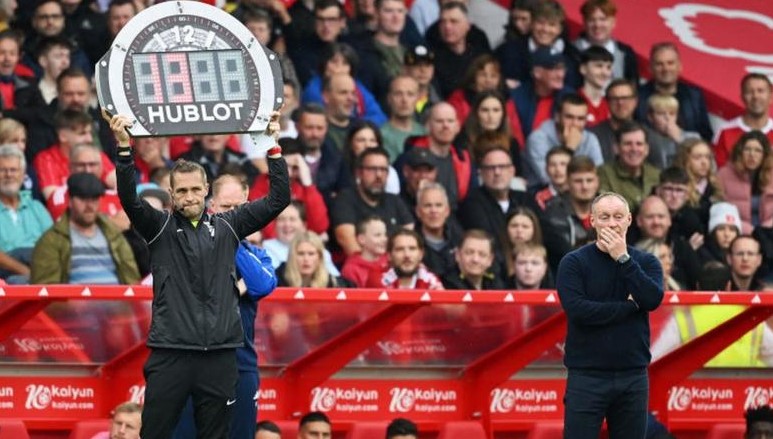One of the primary topics of discussion throughout the first eight weeks of the 2023–24 Premier League season has been the total amount of time that is put on to the end of each match.
In an effort to cut down on the amount of time that is wasted during matches, the Professional Game Match Officials’ League (PGMOL), which oversees referees in England, has decided to increase the amount of stoppage time that is used.
As a consequence of this, matches in the highest division typically last longer than one hundred minutes.
On the other hand, the new regulations have been called “absurd” by some people, and they have not been implemented in European competitions since players have voiced concerns about their welfare in light of the move.
In light of the fact that there have already been eight gameweeks played, what impact have they had on the Premier League?
How much longer do matches typically last?
The men’s World Cup that was held in Qatar the previous year was the first time that extended durations of extra time were used.
This resulted in previously unheard-of lengths of added time and some of the longest games in the history of the competition – with more than 27 minutes of additional time being put on to the match between England and Iran as the most extreme occurrence.
Since the beginning of the current campaign in the Premier League, when that regulation was first put into effect, there have been a total of 80 games played, and the average amount of time that has been added onto the end of each of those games is currently 11 minutes 33 seconds.
That represents an improvement on the previous year’s average of eight minutes and 27 seconds, which you may have expected to see.
The match between Fulham and Sheffield United, which Fulham won 3-1, was the longest one thus far. Despite the fact that Chris Basham, a defender for the Blades, suffered a catastrophic injury during the match, which ended after 113 minutes and 54 seconds, the match was overshadowed by the injury.
Does the length of the match affect the amount of action?
The goal of ensuring that the ball is kept in play for a greater amount of time was one of the primary motivating elements behind the crackdown on wasting time.
Former referee Mark Clattenburg made the proposal a year ago to play matches for only 60 minutes while stopping the clock in an effort to eliminate gamesmanship.
The data, at least in relation to the Premier League, provided support for the concept.
The previous year’s competition had the lowest average ‘ball in play’ time in more than a decade, clocking in at just 54 minutes and 52 seconds on average.
Has the more stringent approach produced the results that were hoped for?
A total of 58 minutes and 48 seconds has been recorded as the average time that the ball is in play during Premier League matches. This represents an increase of almost four minutes compared to the previous season.
Have we witnessed any more of the late-night drama?
More time put on equals more opportunities for late-game drama, and that is precisely what we have seen so far in the Premier League season of 2023–24.
This season there have already been a total of 32 goals scored in injury time, and that number includes goals scored in both the first and second halves of matches. This represents 13.3% of the total amount of goals scored thus far.
In comparison, there had been a total of just 11 goals scored in injury time through the first eight games of the previous season.
During the entirety of the 2022-23 season, a total of 84 goals were scored in injury time, with that number representing 7.7% of the total number of goals scored.
Since August, we have witnessed three of the five latest goals in the history of the Premier League. These goals were scored by Arsenal’s Gabriel Jesus (100:15), Aston Villa’s Leon Bailey (100:09), and Tottenham’s Dejan Kulusevski (99:53).
Are the ‘larger’ clubs given an advantage by the changes?
Everton manager Sean Dyche was quoted as saying that he believed the implementation of the five substitute rule would be beneficial to larger teams because of their capacity to create better squads. The rule was introduced during the previous season.
However, when taken into account with the additional time that was added to this campaign, do the data support that view?
This season, there have already been 24 goals scored in the second half of matches during injury time. This amount is already almost half of the total goals scored throughout the entirety of previous season (49), even though there are still 30 matchdays left.
At this point in the previous season, there had only been five goals scored in the second half of injury time, therefore this is a substantial improvement.
However, a general pattern has not yet begun to take shape.
This season, the teams that are now tied for first place in the league, Arsenal and Tottenham, as well as Aston Villa, have scored three goals in the second half of added time.
They are followed by Manchester United, Newcastle United, and Liverpool, all of whom finished in the top five of the Premier League the previous season, as well as Brentford, who each have two points. At least one is present at fourteen of the twenty clubs in total.
With only eight matchdays under our belts, there is still plenty of time for new patterns to surface. It is apparent that the new regulations have had a substantial influence because there is an average of more than three minutes of more stoppage time added to each contest, which results in a total amount of additional time added per matchday that is close to two hours.




